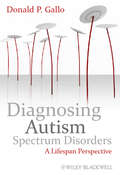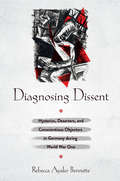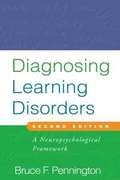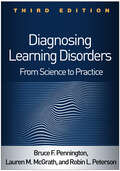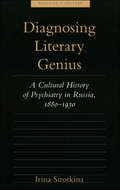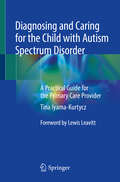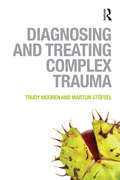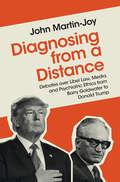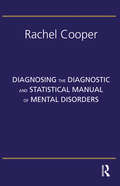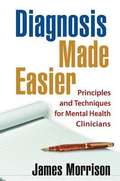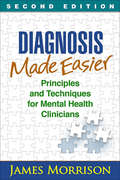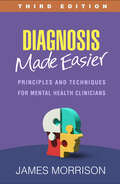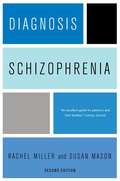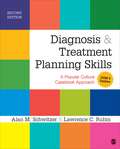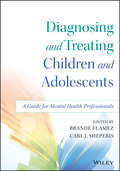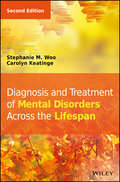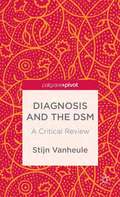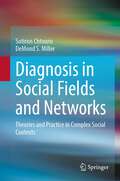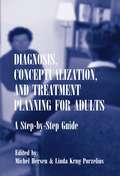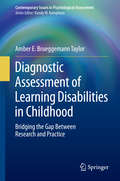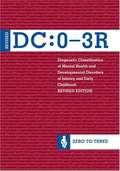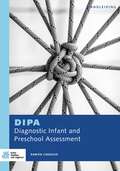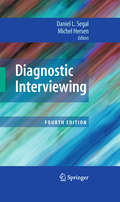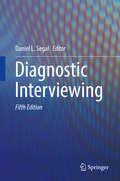- Table View
- List View
Diagnosing Autism Spectrum Disorders
by Donald P. GalloDiagnosing Autism Spectrum Disorders: A Lifespan Perspective is the first book of its kind to provide authoritative information for medical and mental health professionals on how to properly evaluate and diagnose autism spectrum disorders in individuals of all ages. The first book of its kind which demonstrates how to conduct an appropriate diagnostic interview to assess a child for an Autism Spectrum Disorder Considers the issues of Autism Spectrum Disorders in children, teenagers, and adults Aimed at both medical and mental health professionals Includes an in-depth treatment of the entire diagnostic process
Diagnosing Dissent: Hysterics, Deserters, and Conscientious Objectors in Germany during World War One
by Rebecca Ayako BennetteAlthough physicians during World War I, and scholars since, have addressed the idea of disorders such as shell shock as inchoate flights into sickness by men unwilling to cope with war's privations, they have given little attention to the agency many soldiers actually possessed to express dissent in a system that medicalized it. In Germany, these men were called Kriegszitterer, or "war tremblers," for their telltale symptom of uncontrollable shaking. Based on archival research that constitutes the largest study of psychiatric patient files from 1914 to 1918, Diagnosing Dissent examines the important space that wartime psychiatry provided soldiers expressing objection to the war.Rebecca Ayako Bennette argues that the treatment of these soldiers was far less dismissive of real ailments and more conducive to individual expression of protest than we have previously thought. In addition, Diagnosing Dissent provides an important reevaluation of German psychiatry during this period. Bennette's argument fundamentally changes how we interpret central issues such as the strength of the German Rechtsstaat and the continuities or discontinuities between the events of World War I and the atrocities committed—often in the name of medicine and sometimes by the same physicians—during World War II.
Diagnosing Learning Disorders, Second Edition
by Bruce PenningtonFrom a trusted expert in the field, this authoritative work provides an accessible overview of what learning disorders are, how they develop, and how to diagnose and treat them effectively. The author presents the most current neuroscientific knowledge on a range of conditions, including dyslexia, autism spectrum disorders, attention-deficit/hyperactivity disorder, and others. Practitioners gain vital insights and tools for making sense of children's impairments and strengths, collecting and interpreting diagnostic data from a variety of sources, and linking diagnosis to evidence-based interventions. The second edition has been substantially revised and expanded to reflect significant clinical and research advances. New to This Edition Covers additional disorders intellectual disability, mathematics disorder, and developmental coordination disorder, plus a chapter on less well-validated disorders. New case illustrations and a focus on empirically based practice. Now grounded in a multiple cognitive-deficit model of learning disorders, replacing the prior edition's modular, single-deficit model. An illuminating chapter on controversial therapies separates myths from facts.
Diagnosing Learning Disorders, Third Edition: From Science to Practice
by Bruce F. Pennington Lauren M. McGrath Robin L. PetersonA definitive reference--now extensively revised with 70% new material--this book presents cutting-edge knowledge on how learning disorders develop and how to diagnose and treat them effectively. In additional to dyslexia and mathematics disabilities, the book covers speech and language disorders, attention-deficit/hyperactivity disorder, autism spectrum disorder, and intellectual disability. Accessibly written, it is grounded in genetics, neuroscience, and developmental neuropsychology. Clinicians and educators are guided to make sense of children's impairments and strengths and make sound diagnostic decisions. Best practices in intervention are reviewed. User-friendly features include case examples and summary tables in each disorder-specific chapter. New to This Edition *Revised throughout to reflect major theoretical, empirical, and technological advances. *Chapters on etiology, brain development, and comorbidity. *Chapters on DSM-5 diagnosis of specific learning disorder, evidence-based assessment, and achievement gaps.
Diagnosing Literary Genius: A Cultural History of Psychiatry in Russia, 1880-1930 (Medicine and Culture)
by Irina SirotkinaWinner of the Aldo and Jeanne Scaglione Prize for Studies in Slavic Languages and Literatures from the Modern Language AssociationThe vital place of literature and the figure of the writer in Russian society and history have been extensively studied, but their role in the evolution of psychiatry is less well known. In Diagnosing Literary Genius: A Cultural History of Psychiatry in Russia, 1880-1930, Irina Sirotkina explores the transformations of Russian psychiatric practice through its relationship to literature. During this period, psychiatrists began to view literature as both an indicator of the nation's mental health and an integral part of its well-being. By aligning themselves with writers, psychiatrists argued that the aim of their science was not dissimilar to the literary project of exploring the human soul and reflecting on the psychological ailments of the age.Through the writing of pathographies (medical biographies), psychiatrists strengthened their social standing, debated political issues under the guise of literary criticism, and asserted moral as well as professional claims. By examining the psychiatric engagement with the works of Fyodor Dostoevsky, Nikolai Gogol, Leo Tolstoy, and the decadents and revolutionaries, Sirotkina provides a rich account of Russia's medical and literary history during this turbulent revolutionary period.
Diagnosing and Caring for the Child with Autism Spectrum Disorder: A Practical Guide for the Primary Care Provider
by Tina Iyama-KurtyczThis unique resource is designed to be a practical, user-friendly guide for pediatricians, primary care providers, and all healthcare providers who work with children with autism spectrum disorder. Diagnosing and Caring for the Child with Autism Spectrum Disorder offers state-of-the art instruction to clinicians on how to recognize, diagnose and assist children with autism spectrum disorders, from early in life to transition to adulthood. This book will also delve into how to support pediatric patients by working with families, and discuss how to best interact with and support these families. The book opens with a comprehensive introduction of ASD and obstacles to diagnosis and common myths. Section Two is devoted to the early recognition of atypical development and reviews the steps in diagnosing autism, including the evaluation, the diagnostic visit, the developmental exam, and the discussion of findings with parents. Section Three covers treatment and interventions for the autism spectrum and includes a discussion on alternative therapies and how to direct parents toward evidence-based or plausible treatments. Section Four and Five addresses special topics that are relevant to the PCP’s or pediatrician’s long-term relationship with families, including chapters on anxiety, parents, challenging behaviors and common scenarios that occur across childhood for those who have ASD. Later chapters delve more deeply into providing informed, sensitive care for patients with intersecting identities, and discusses how gender identity and cultural perspective and attitudes can impact the pediatric patient with ASD. Engaging, and written in a conversational style, Diagnosing and Caring for the Child with Autism Spectrum Disorder will be an ideal resource for the pediatrician, primary care provider, and all healthcare providers working with children with ASD, providing concrete, step-by-step methods that readers can incorporate into their own practice.
Diagnosing and Treating Complex Trauma
by Martijn Stöfsel Trudy MoorenThe term complex trauma refers to a broad range of symptoms resulting from exposure to prolonged or repeated severely traumatizing events. This broad spectrum of psychological symptoms complicates the formulation of an all-encompassing explicit definition, which in turn complicates the creation of specific treatment guidelines. In Diagnosing and Treating Complex Trauma, Trudy Mooren and Martijn Stöfsel explore the concept of complex trauma with reference to severely traumatised people including refugees, asylum seekers, war veterans, people with severe occupational trauma and childhood trauma and others who have dealt with severe violence. <P><P> The book introduces a layered model for diagnosing and treating complex trauma in four parts. Part One introduces the concept of complex trauma, its historical development and the various theories about trauma. The authors introduce a layered model that describes the symptoms of complex trauma, and conclude with a discussion on the three-phase model. Part Two describes the diagnostic options available that make use of a layered model of complex trauma. Part Three discusses the treatment of complex trauma using the three-phase model as an umbrella model that encompasses the entire treatment. Chapters cover a multitude of stabilization techniques crucial to the treatment of every client group regardless of the therapeutic expectations. This part also contains an overview of the general and specific trauma processing techniques. The last chapter in this part covers the third phase of the treatment: integration. Part Four addresses the characteristics of different groups of clients who are affected by complex trauma, the components that affect their treatment and the suggested qualities required of a therapist to deal with each group. The book concludes with a chapter discussing the consequences for therapists providing treatment to people afflicted by complex trauma. <P><P> Developed from the authors’ own clinical experiences, Diagnosing and Treating Complex Trauma is a key guide and reference for healthcare professionals working with severely traumatised adults, including psychologists, psychotherapists, psychiatrists, social-psychiatric nurses, and case managers.
Diagnosing from a Distance: Debates over Libel Law, Media, and Psychiatric Ethics from Barry Goldwater to Donald Trump
by John Martin-JoyEver since the rise of Adolf Hitler, mental health professionals have sought to use their knowledge of human psychology to understand - and intervene in - political developments. From Barry Goldwater to Donald Trump, psychiatrists have commented, sometimes brashly, on public figures' mental health. But is the practice ethical? While the American Psychiatric Association prohibits psychiatric comment on public figures under its 'Goldwater Rule', others disagree. Diagnosing from a Distance is the first in-depth exploration of this controversy. Making extensive use of archival sources and original interviews, John Martin-Joy reconstructs the historical debates between psychiatrists, journalists, and politicians in an era when libel law and professional standards have undergone dramatic change. Charting the Goldwater Rule's crucial role in the current furor over Trump's fitness for office, Martin-Joy assesses the Rule's impact and offers a more liberal alternative. This remarkable book will change the way we think about psychiatric ethics and public life.
Diagnosing the Diagnostic and Statistical Manual of Mental Disorders: Fifth Edition
by Rachel CooperThe Diagnostic and Statistical Manual of Mental Disorders, more commonly known as the DSM, is published by the American Psychiatric Association and aims to list and describe all mental disorders. The publication of DSM-V in 2013 brought many changes. Diagnosing the Diagnostic and Statistical Manual of Mental Disorders is written for all those who wonder whether the DSM-V now classifies the right people in the right way. It is aimed at patients, mental health professionals, and academics with an interest in mental health. Issues addressed include: What are the main changes that have been made to the classification? How is the DSM affected by financial links with the pharmaceutical industry? To what extent were patients involved in revising the classification? How are diagnoses added to the DSM? Does medicalisation threaten the idea that anyone is normal? What happens when changes to diagnostic criteria mean that people lose their diagnoses? How important will the DSM be in the future?
Diagnosis Made Easier
by James Morrison Richard BalonThis authoritative, user-friendly book offers a complete introduction to the art and science of mental health diagnosis. Meeting a key need for students and novice clinicians, James Morrison, the author of the bestselling DSM-IV Made Easy, systematically takes the reader through every step of the process. He provides clear-cut principles and decision trees for evaluating information from a variety of sources and for constructing a valid working diagnosis that serves as a foundation for treatment. Special features include quick-reference tables, sidebars explaining key concepts, and over 100 case examples that bring the approach to life.
Diagnosis Made Easier, Second Edition: Principles and Techniques for Mental Health Clinicians
by James MorrisonThis popular practitioner guide and course text takes the reader step by step through diagnostic decision making in mental health. Acclaimed for both the clarity of his writing and his clinical expertise, James Morrison provides principles and decision trees for evaluating information from multiple sources and constructing a valid, clinically useful working diagnosis. More than 100 vivid vignettes--from the straightforward to the toughest cases--illustrate the practical application of these methods. Essential topics include developing a differential diagnosis, dealing with comorbidity; and determining when physical illness may be the cause of mental health symptoms. New to This Edition *Revised throughout for DSM-5. *Updated resources and suggested readings.
Diagnosis Made Easier: Principles and Techniques for Mental Health Clinicians
by James MorrisonThe third edition of this incisive practitioner resource and course text--updated for the DSM-5 Text Revision (DSM-5-TR)--takes the reader step by step through diagnostic decision making in mental health. Guidelines are presented for evaluating information from multiple sources, constructing a wide-ranging differential diagnosis, creating a safety hierarchy, and using decision trees to derive a valid working diagnosis. The book addresses specific issues in diagnosing the conditions most often seen in mental health practice, with an emphasis on how diagnosis informs effective treatment. More than 100 vivid vignettes illustrate the diagnostic process and allow readers to practice their skills. New to This Edition *Revised throughout for DSM-5-TR, including the new diagnosis of prolonged grief disorder. *Chapter on eating and sleeping disorders, including new decision trees. *New and updated vignettes and suggested readings.
Diagnosis Schizophrenia
by Miller Rachel Mason Susan E.In this book, thirty-five young, recently diagnosed patients speak about schizophrenia and the process of recovery, while two specialists illuminate the medical science, psychoeducation, and therapeutic needs of those coping with the illness, as well as access to medical benefits and community resources. A remarkably inclusive guide, the volume informs patients, families, friends, and professionals, detailing the possible causes of schizophrenia, medications and side effects, the functioning of the brain, and the value of rehabilitation and other services. In their dialogues, participants confront shame, stigma, substance use, and relapse issues and the necessity of healthy eating, safe sex practices, and coping skills during recovery. Clinicians elaborate on the symptoms of schizophrenia, such as violent and suicidal thoughts, delusions, hallucinations, memory and concentration problems, trouble getting motivated or organized, and anxiety and mood disorders. Adopting an uplifting tone of manageability, the participants, authors, and clinicians of this volume offer more than advice& mdash;they prescribe hope.
Diagnosis and Treatment Planning Skills: A Popular Culture Casebook Approach (2nd Edition) (DSM-5 Update)
by Lawrence C. Rubin Alan M. SchwitzerThe Second Edition of Alan M. Schwitzer and Lawrence C. Rubin's Diagnosis and Treatment Planning Skills: A Popular Culture Casebook Approach comprehensively addresses the clinical thinking skills required in professional counseling settings through the innovative use of case examples drawn from popular culture. Fully revised to include DSM-5, the text begins with discussion of diagnosis, case conceptualization, and treatment planning, covering the interplay of individual clinical tools and their application in contemporary practice. Ten DSM-5 updated case illustrations follow, creating a streamlined new edition that engages students in a start-to-finish application of clinical tools.
Diagnosis and Treatment of Children and Adolescents
by Brande Flamez Carl J. SheperisA guide to treating mental health issues in children and adolescents Diagnosis and Treatment of Children and Adolescents: A Guide for Mental Health Professionals is a resource tailored to the particular needs of current and future counselors, behavioral healthcare clinicians, and other helping professionals working with this vulnerable population. With in-depth content broken into two sections, this book first provides a foundation in the diagnostic process by covering the underlying principles of diagnosis and treatment planning, and then applies this framework to the DSM-5 categories related to children and adolescents. With research continually reshaping our understanding of mental health, it is critical mental health professionals make decisions based on evidence-based pathways that include the specialized research around children and adolescents. The leading experts who contributed to this book share contemporary perspectives on developmental considerations, assessment information, presenting symptoms, comorbidity, levels of severity, prevalence data, and other relevant factors. Structured content of chapters provides a crosswalk between the DSM-5 and this book Updated content based upon the changes, additions, and revisions to the DSM-5 that affect diagnosis, assessment, and treatment Pedagogical features, such as learning objectives, case studies, guided practice exercises, and additional resources, to support effective learning Diagnosis and Treatment of Children and Adolescents: A Guide for Clinical and School Settings is a critical resource for mental health practitioners and graduate students working toward a career in a mental health profession.
Diagnosis and Treatment of Mental Disorders Across the Lifespan
by Stephanie M. Woo Carolyn KeatingeA versatile reference text for developing and applying clinical psychopathology skills Designed to serve as a trusted desktop reference on mental disorders seen across the lifespan for mental health professionals at all levels of experience, Diagnosis and Treatment of Mental Disorders Across the Lifespan, Second Edition expertly covers etiology, clinical presentation, intake and interviewing, diagnosis, and treatment of a wide range of DSM disorders at all developmental stages. Unlike other references, this book takes a lifespan approach that allows readers to develop the clinical skills necessary to respond to mental health concerns in a patient-centered manner. Introductory and advanced features support clinicians at every stage of their careers and help students develop their skills and understanding. Authors Woo and Keatinge combine a review of cutting edge and state-of-the-art findings on diagnosis and treatment with the tools for diagnosing and treating a wide range of mental disorders across the lifespan. . This second edition incorporates the following changes: Fully updated to reflect the DSM-5 Chapters have been reorganized to more closely follow the structure of the DSM-5 Cultural and diversity considerations have been expanded and integrated throughout the book A new integrative model for treatment planning Expanded discussion of rapport building skills and facilitating active engagement Identity issues and the fit between client and intervention model has been added to the case conceptualization model Mental health disorders affect patients of all ages, and the skilled clinician understands that there are no one-size-fits-all treatments. Diagnosis and Treatment of Mental Disorders Across the Lifespan, Second Edition will instruct clinicians and students in psychopathology for every life stage. Praise for the first edition: Reviews This handbook, Diagnosis and Treatment of Mental Disorders Across the Lifespan, comprehensively integrates best practices necessary for clinicians who deal with a wide range of mental disorders across the continuum of development in a practical, applied, and accessible manner. One of the unique aspects of the book is the length to which the authors go to ensure that the up-to-date information contained in the book is practical, user-friendly, and accessible to beginners in clinical practice
Diagnosis and the DSM: A Critical Review
by Stijn VanheuleThis book critically evaluates the fifth edition of the Diagnostic and Statistical Manual of Mental Disorders (DSM-5). Through analysis of the history of psychiatric diagnosis and of the handbook itself, it argues that the DSM-5 has a narrow biomedical approach to mental disorders, and proposes a new contextualizing model of mental health symptoms.
Diagnosis in Social Fields and Networks: Theories and Practice in Complex Social Contexts
by DeMond S. Miller Sotirios ChtourisContaining a novel compilation of theoretical and methodological approaches, this textbook lays out the most relevant foundations of clinical sociology. Relying heavily on well-recognized medical models and concepts to help communicate ideas (e.g. treatment, diagnosis, clinical, cure), the methods of social diagnosis and social therapy presented in this book will help in better and socially informed protection of vulnerable individuals and citizens as well as an informed design of protection policies for macro, meso and micro levels of society. The book explains that many problems, perceived as economic, psychological-individual, and political, are rooted in social functions and structures of the wider society, and how these social structures and functions interact in everyday life. Through the application of the theoretical and methodological approaches in case studies on recent issues, such as the Covid pandemic, or the Hurricane Katrina disaster, the book will allow readers to easily cope with the complexity of clinical sociology and to develop clinical competencies and pertinent training. This renders the book not only highly useful for advanced undergraduate and graduate students of clinical and applied sociology but also for the preparation of courses for theoretically informed practitioners who are keen to work by defining learning objectives and learning paths.
Diagnosis, Conceptualization, and Treatment Planning for Adults: A Step-by-step Guide
by Michel Hersen Linda Krug PorzeliusIn spite of the theoretical knowledge of diagnosis and assessment, case conceptualization, and treatment planning imparted by their course instructors, most students are confused about the interrelationships of these processes in practice and are unable to apply what they have learned to the solution of thorny client problems. This book is designed to bridge the gap between classroom and clinic. In pragmatic fashion it walks beginners through the strategies needed to work with adults in outpatient settings and answers the questions they most frequently ask their clinical supervisors at the outset of their clinical apprenticeships. Three chapters succinctly summarize the crucial general information and skills that must be reflected in a clinician's approach to any client. Then, following a standard format that facilitates understanding and comparison, experts describe specific disorders one by one and present their own illustrative cases to point the way to effective targeting. Diagnosis, Conceptualization, and Treatment Planning for Adults will be an indispensable guide for mental health professionals in training who are facing their first assignments with clients.
Diagnosis: A Comprehensive Resource for Consumers, Families, and Helping Professionals, Second Edition
by Rachel MillerIn this book, thirty-five young, recently diagnosed patients speak about schizophrenia and the process of recovery, while two specialists illuminate the medical science, psychoeducation, and therapeutic needs of those coping with the illness, as well as access to medical benefits and community resources. A remarkably inclusive guide, the volume informs patients, families, friends, and professionals, detailing the possible causes of schizophrenia, medications and side effects, the functioning of the brain, and the value of rehabilitation and other services. In their dialogues, participants confront shame, stigma, substance use, and relapse issues and the necessity of healthy eating, safe sex practices, and coping skills during recovery. Clinicians elaborate on the symptoms of schizophrenia, such as violent and suicidal thoughts, delusions, hallucinations, memory and concentration problems, trouble getting motivated or organized, and anxiety and mood disorders. Adopting an uplifting tone of manageability, the participants, authors, and clinicians of this volume offer more than advice-they prescribe hope.
Diagnostic Assessment of Learning Disabilities in Childhood
by Amber E. Brueggemann TaylorDiagnosing learning disabilities (LD) in children has never been an easy task. The multiple approaches in use complicate the assessment process, raising the risk of young students getting the wrong services, or none at all. It is clear that more accurate diagnosis and classification methods are needed to advance the prevention and treatment of difficulties in reading and mathematics. Diagnostic Assessment of Learning Disabilities in Childhood takes important steps to cut through the confusion. This timely resource weighs the strengths and weaknesses of commonly used assessment methods including the aptitude-achievement discrepancy, cognitive processing, RTI and low achievement approaches and introduces the author's academic impairment model as a promising alternative. A chapter on comorbid disorders in students with LD guides readers in the fine points of differential diagnosis. And to make the coverage especially practical, the book's features link the theoretical to the real-world practice of LD assessment, among them: Overviews of LD identification and definitions. Analysis of widely used diagnostic approaches with strengths and weaknesses. Examples of assessment protocols and report writing. Case examples illustrating diagnostic issues. Q&A sections with leading experts in the field. Useful summaries, appendices and resource links. Diagnostic Assessment of Learning Disabilities in Childhood is an invaluable reference for school and clinical child psychologists, special education and allied educational professionals and researchers and graduate students in school, educational and clinical child psychology who are dedicated to higher measurement standards and greater opportunities for children's academic success.
Diagnostic Classification of Mental Health and Developmental Disorders of Infancy and Early Childhood (Revised)
by Zero To Three StaffZERO TO THREE'S Diagnostic Classification of Mental Health and Developmental Disorders of Infancy and Early Childhood (DC:0-3), published in 1994, was designed to address the need for a systematic, developmentally based approach to the classification of mental health and developmental difficulties in the first 4 years of life.
Diagnostic Infant and Preschool Assessment DIPA handleiding
by Ramon LindauerDe Diagnostic Infant and Preschool Assessment (DIPA) is een semigestructureerd klinisch interview waarmee de psychopathologie van kinderen in de leeftijd van één tot en met zeven jaar in beeld kan worden gebracht. Met de DIPA kunnen de volgende psychische stoornissen volgens de DSM-5-classificatie worden vastgesteld: posttraumatische-stressstoornis, depressieve stoornis, disruptieve stemmings-disregulatiestoornis, aandachtsdeficientie-/hyperacitiviteitsstoornissen, oppositioneel-opstandige stoornis, normoverschrijdend-gedragsstoornis, separatieangststoornis, specifieke fobie, sociale-angststoornis, gegeneraliseerde-angststoornis, obsessieve-compulsieve stoornis, reactieve hechtingsstoornis, ontremd-sociaalcontactstoornis, en problemen met in- en doorslapen.Met de DIPA worden de frequentie, intensiteit, duur, start en interferentie van de symptomen vastgesteld. De DIPA is ook uitermate geschikt om behandeleffecten te meten. Het interview wordt afgenomen bij ouders of andere primaire verzorgers door psychologen, orthopedagogen, kinder- en jeugdpsychiaters en andere professionals met ruime klinische ervaring met psychodiagnostiek bij jonge kinderen.
Diagnostic Interviewing
by Michel Hersen Daniel L. SegalThis volume represents a clear, jargon-free overview of diagnostic categories with helpful hints regarding a psychiatric interview. Completely revised and updated, detailing current innovations in theory and practice, including recent changes in the DSM-IV.
Diagnostic Interviewing
by Daniel L. SegalThis volume represents a clear, jargon-free overview of diagnostic categories with helpful hints regarding a psychiatric interview. Completely revised and updated, detailing current innovations in theory and practice, including recent changes in the DSM-IV.
